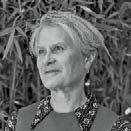20 Interviews on the Future of Building
71
81
89
Contents
Preface Cities and Regions
Building Responsibly Marina Tabassum 21 Climate Change as a Social Issue Tatiana Bilbao 33 Testing Ground to Save the World Tarik Oualalou
Living with Water Kunlé Adeyemi
Copenhagen’s Climate Neutral Path Camilla van Deurs
Climate Shelters for Barcelona Lacol
04
11
41
51
61
Design as Problem Solver Shigeru Ban
Singapore as a Model Green City for the Future Richard Hassell
Corridors for Life Richard Weller
Circular
99
Michael Pawlyn
109
Barbara Buser
121
Anders Lendager
133
Lamia Messari-Becker
143 Building in Material Cycles
Catherine De Wolf
153 Building without Waste
Michael Braungart
Ressourcen und Reserven
169 A Dance between Old and New Inge Vinck
179 Building with Wood –but Differently
Alan Organschi
189 Craft as a Source of Energy
Anna Heringer
199 Creative Solutions to Combat the Climate Crisis
Sarah Wigglesworth
211 Potential of Clay Architecture
Roger Boltshauser
and CO2-neutral
What to Do about the Climate Emergency?
Radically Transforming the Construction Industry
Who Will Run the Urban Mines of the Future?
How Do We Shift to Sustainable Construction?
Interview Kunlé Adeyemi
Livingwith Water
How can coastal cities adapt to rising sea levels? In conversation with Heide Wessely, Nigerian architect Kunlé Adeyemi discusses solutions to climate change.
Sea levels are rising. Can architecture influence climate change, or can architects only react to its effects?
Architects and planners can play a huge role in climate change as we think about the built environment and how to design for the future. But that question should have been asked and answered 20 years ago. Unfortunately, we are now on quite a steep trajectory with the impacts of climate change. That’s why we should not only think about changing the built environment but also adapting to the changing natural environment. In terms of rising sea levels, we must learn to live with water instead of trying to fight it.
In which ways?
We could build on the water on floating structures or stilts. Many indigenous communities have lived on and around water for millennia, especially in Africa and Asia – the continents most affected by climate change today. We are working to understand how these communities live with water and to develop that into a new way of living. There are countless settlements built around and on the water that work well. The easiest solution is to learn from them. We also need to reduce our reliance on concrete and use nature-based building materials instead, like wood, bamboo, and stone. They are great materials that are used where they grow. It doesn’t make sense to transport building materials around the world.
How can modern cities learn from indigenous settlements?
Kunlé Adeyemi

44
The Floating Music Hub by Kunlé Adeyemi is a space for music and cultural events made of prefabricated timber elements. It is anchored in Mindelo, Cape Verde.
We need to allow more water into the urban fabric of our cities and create waterways. In April of 2022, hundreds of people died from the floods in Durban, South Africa. I studied the city with my students at Harvard a few years ago, and even then, we saw that flood mitigation measures were lacking. Solutions exist, but they have yet to be developed. First, we need a change of mindset; 80 % of our major cities and capitals around the world are located on a waterfront. Many of them, especially in developing countries, are growing very fast. Those are two major challenges: rapid urbanization and climate change. If we look at water as a new property to be developed, we could build entire water cities.
You grew up in Lagos and have long lived in Amsterdam. Don’t these very different societies and cultures need different solutions?
Yes, in Nigeria, the reality is very different from that in the Netherlands; Lagos alone has more people than all of the Netherlands. The challenges and how they are dealt with are inherently very different. In Nigeria, there is a strong awareness of the immediate impact that human actions have; social responsibility is deeply ingrained in the African context. In the Netherlands, a strong awareness of environmental sustainability has led to new technologies. Combining these two approaches would be very valuable. A sense of social responsibility would benefit many parts of the West, and Western technologies would be helpful to many African cities.
What do you think about knowledge sharing between Africa and the Western world?
I definitely think an exchange of ideas can be beneficial, but it is not as straightforward as simply taking an idea and applying it to another context. Solutions must be relevant to the particular situation and should mostly be homegrown. One place with
Kunlé Adeyemi
close parallels to the Netherlands is Makoko, a vast informal settlement mainly built on stilts in the Lagos Lagoon. The urban fabric of Amsterdam already has a great deal of water, but there are still plenty of opportunities to increase real estate by creating more infrastructure directly on water as opposed to the costly practice of land reclamation. The Netherlands has technologies, knowledge, and resources to solve problems like waste management, sewage, and power. But the Dutch could still learn a lot from the inhabitants of Makoko about embracing water as a way of life.
Your floating school prototype in Lagos has evolved into the Makoko Floating System. How does it work, and where is it being built?

Locally sourced materials
46
Repairs prolong lifespan
Job creation
Disassembly
“We need to let water into our cities, not fight against it.”
Kunlé Adeyemi
Who Will Run the Urban Mines of the Future?
Anders Lendager
Interview
Danish architect Anders Lendager is one of the most radical pioneers of circular construction. In this interview with Jakob Schoof, he explains how architects can help end the throwaway society.
You are an architect, but you also run a consulting firm and, until recently, have been involved in a number of companies that manufacture building products. How did that come about?
As an architect, I know that clients ask about cost whenever the subject of sustainability comes up and I’ve seen how little established manufacturers cared about recycling building materials. So I realized that I had to take care of those things myself. Today, we advise companies and municipalities who want to find out what materials are used in their building stock. This often leads to building projects for my architectural practice – and in turn to a demand for upcycled building products. To satisfy it, until a few weeks ago I ran a development and production company for recycled building products. I have now sold this company to investors, which I think is a milestone for the circular business model that we have established.
That’s not an everyday business model for an architect.
In my case, it was necessary. And I think as architects we can’t afford in the long run to always be drawing grand plans and letting others bear the financial risk for them.
What kind of clients do you mainly work with? Private, public, commercial?
All of them. Five years ago it was very different: back then, when you talked to representatives of the big Danish pension funds, they were happy to listen to your ideas – and as soon as
Anders Lendager
you left, they were done with the subject. Nowadays we work with the most conservative investors you can imagine – and they see that they can make money with circular construction. But it should all go much faster. Consumers are often smarter than the industry; they want to live sustainably, and the demand for ecological solutions is so great that the construction industry can’t keep up with deliveries.
You also advise local authorities and companies who want to know what materials are used in their building stock. To what end?
Previously, when these companies wanted to demolish a building and rebuild on the property, they paid the demolition contractor a flat rate. With our method, they can now find out exactly how much concrete, glass, and steel are in a building, what these materials are worth, and how they can be recycled or reused. This gave them a much better bargaining chip on demolition costs. We also show how much money they can save by reusing these materials in new construction. This is where things get really interesting for many investors.
Building materials in existing stock are often contaminated with invisible pollutants like asbestos or PCBs. How problematic is that?
There are now sophisticated methods for measuring the pollutant load of building materials even before demolition. Even if it turns out that 3 % of the building contains pollutants, you can still reuse 97 % of the materials. Here in Denmark we examined buildings from the 1970s whose precast concrete elements are contaminated with PCBs. When heated, the PCB volatilizes. So we built a kind of large oven out of a container in which we thermally decontaminated the concrete elements.
124

New
Upcycled
Upcycle Studios is a townhouse development in Copenhagen by Lendager Architects utilizing construction materials repurposed from other projects. Material
Anders Lendager
46 %52 % 54 %48 % 69 % 31 %
distribution by weight
CostsCO2-equivalents

20 % 80 % 10 % 90 % 91 % 9 %
126 New Upcycled Material distribution by weight CostsCO2-equivalents
Resource Rows, a residential complex in the Ørestad neighbourhood of Copenhagen by Lendager Architects, features a patchwork facade of upcycled brick panels.
You say that recycled building materials don’t have to cost more, and are often cheaper than new ones. What can be done to ensure this actually happens?
Of course, it depends on what you’re reusing. For example, decking from reclaimed wood is easier to produce at a competitive cost than recycled concrete or the brick facades for our Resource Rows project in Copenhagen. But as a rule, the building products we develop from recycled material aren’t more than 10 % more expensive than new comparable products. And after we use them on two or three construction projects and increased their production volume accordingly, they often become 50 to 70 % cheaper.
In Europe, you need approval for reused materials. Doesn’t that complicate the process?
Not more than if you build with new materials. The loadbearing capacity of old steel or concrete beams can be tested and fire protection tests can be carried out with reused materials. I’m probably the best known architect to the Danish fire authorities because I’m always showing up with the craziest materials to get tested! The warranty isn’t a big drama either. A good window lasts for 50 years. So if we remove an existing window after 10 or 15 years and install it in a new house, we can also give a five-year guarantee on it. Where’s the problem?
To what extent does the availability of materials influence your design aesthetic?
That’s an important question I often address: Should recycled materials in buildings be recognizable as such? We have already used both strategies in our projects. If the materials are left visible, they can tell their story. The residents at Resource Rows in Copenhagen, for example, know exactly where the
Anders Lendager
Building with Wood –but Differently
Interview Alan Organschi
American architect Alan Organschi directs the Innovation Lab at the Bauhaus Earth research institute in Berlin. He explains to Jakob Schoof that timber construction is a way to help combat climate change – if we change how we manage forests and use wood.
Since 2021 you have been working for Bauhaus Earth, founded by climate scientist John Schellnhuber. What is this new Bauhaus – a think tank, an educational institution, a lobbying organization?
Basically all of the above. We combine research with education and outreach. Our goal is to promote ecological system change in the building sector with a broad network of actors. This is nothing fundamentally new to Europe. But our main interest is in those countries and bioregions that will experience the greatest population and consumption growth in the coming decades. This is where change in building practice will have the greatest effect.
Where do you see parallels to the historical Bauhaus?
In 1919, the aim was to deal with the consequences of World War I and to create housing for a growing middle class. The war was a catastrophe for Europe. Today we are dealing with a worldwide cataclysm, climate change. And with its enormous emissions, the building sector is in a sense the “elephant in the climate room”, as John Schellnhuber puts it.
One of your focal points is timber construction. Can wood actually serve to address the global demand for new buildings to any significant extent?
Not if we carry on as we do right now. Many innovations in timber construction currently refer to the same types of wood and building products. But it would be completely wrong to
Alan Organschi
use European components made of spruce or beech wood to build elsewhere in the world, to apply the capitalist logic of global trade to these resources and to overexploit regional forests for this purpose. This would only be a continuation of the previous waste of resources by other means.
What would help us instead?
We should think holistically and, at the same time, look more closely: What types of trees grow in a certain region? How can their wood be used? What regional value chains can I create by using them? And how can forests be managed in such a way that they promote biodiversity, continue to serve as CO2 sinks, and prevent forest fires? This may sound idealistic – but given the extent to which forests are already suffering from climate change, we have little choice. By the way, we are not only concerned with building materials and their production, but also with their application: How densely and how tall do we build? How much space do we occupy – as individuals and as a communities? And, what happens at the end of the building life cycle? As long as we end up burning wood instead of reusing it, timber construction will not save us either.
Those are many questions at once. How do you approach such a Herculean task?
We look at things in a regionally differentiated way. At Bauhaus Earth, we are currently investigating four different world regions in transformation labs: Brandenburg, the Western Cape province in South Africa, Thimphu, the capital of Bhutan, and Denpasar in Indonesia. In Brandenburg, for example, we are looking at how we use wood in view of the upcoming forest transformation. We are researching the use of grasses and typha reed from paludiculture and have developed unfired masonry bricks from the gravel and clay of the gravel pits there. In Indonesia, the focus is on the use of bamboo for innovative
182
“As long as we end up burning wood instead of reusing it, timber construction will not save us either.”
Alan Organschi

184
An impressive structure of conjoined timber domes was designed by Gray Organschi Architecture for their carousel pavilion at Mill River Park in Stamford, Connecticut.
laminated wood products and, in the Cape Province, on ways of using eucalypt wood. In that region, eucalyptus is an invasive species that grows in large quantities. Curbing its growth makes sense in ecological terms.
And in Bhutan?
Many construction projects in the country still use concrete, mostly with cement imported from India. Yet, Bhutan is rich in forests, many of which are protected. Although timber structures are being built, the material is used very inefficiently and wood waste is not reused. Together with the forestry sector and local companies, we are now trying to diversify the product range so that more buildings can be made of wood without depleting the forests. We are also developing financing methods and working on higher energy standards for buildings, with the aim of reducing consumption here as well.
How should forests be managed in the future?
First of all, they should be managed from the get-go. If forests are left to their own devices in times of climate change, they risk turning from a CO2 sink into a CO2 source and start emitting greenhouse gases. Monocultures aren’t the solution, either. We need increased biodiversity and crop rotation in timber plantations and commercial forests, similar to agriculture. And we must learn to use the residual wood that is collected in the course of forest maintenance.
A greater range of tree species would also result in an increased diversity of wood processing technologies. Will this lead to greater demands for research and investment?
Exactly – and this is also the reason why such ideas still encounter great resistance in the construction and timber industries.
Alan Organschi
Conversation Partners









222
211 Roger Boltshauser
71 Shigeru Ban
81 Richard Hassell
189 Anna Heringer
143 Catherine De Wolf
153 Michael Braungart
41 Kunlé Adeyemi
21 Tatiana Bilbao
109 Barbara Buser











Conversation Partners
99 Michael Pawlyn
13 Anders Lendager
199 Sarah Wigglesworth
89 Richard Weller
169 Inge Vinck
179 Alan Organschi
51 Camilla van Deurs
13 Lacol
13 Lamia Messari-Becker
11 Marina Tabassum
33 Tarik Oualalou
Imprint
Editor
Dr. Sandra Hofmeister
Interviewers
Vera Simone Bader, Jan D. Geipel, Edeltraud Haselsteiner, Sandra Hofmeister, Frank Kaltenbach, Julia Liese, Peter Popp, Jakob Schoof, Heide Wessely, Barbara Zettel
Project Management
Edith Walter
Editorial Support
Laura Traub
Translations
Alisa Kotmair, Mark Kammerbauer
Proofreading
Alisa Kotmair
Design
Claudia Scheer, Manuel Federl (Berlin, DE)
→ muskat.design
DTP
Simone Soesters
Reproduction
ludwig:media (Zell am See, AT)
→ ludwigmedia.at
Printing and Binding
Gutenberg Beuys Feindruckerei (Langenhagen, DE)
→ feindruckerei.de
Paper
Cover: Chromosulfate
cardboard 280 g
Content: Munken Print
White 100 g
This book has been made from materials that originate from responsibly managed, FSC®-certified forests and other verified sustainable sources. LOGO
234

























